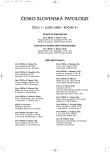Acute Aortic Syndromes
Authors:
I. Šteiner
Authors‘ workplace:
Fingerlandův ústav patologie LF UK a FN, Hradec Králové
Published in:
Čes.-slov. Patol., 41, 2005, No. 1, p. 7-11
Category:
Original Article
Overview
The term acute aortic syndrome comprises in addition to classic dissection also two recently described entities – penetrating ulcer and intramural haematoma. Forty-two necropsy cases of acute aortic syndrome were encountered during the last six years – 41 dissections and one penetrating ulcer; the intramural haematoma was not seen.
According to the DeBakey classification, there were 26 dissections of type I, 8 of type II, 1 of type IIIA, and 4 of type IIIB; in 2 cases the dissection was confined to the abdominal aorta. The dissection had a chronic character in four cases. Aortic rupture was found in 24 cases (59 %), most frequently (19x) into the pericardial cavity. The aortic dissection continued into aortic branches in 25 patients (61 %), causing stenosis/obstruction of coronary arteries in 7, of branches of the arch in 20, of abdominal arteries in 12, and of renal arteries in 17 patients, respectively.
Histologically, there were degenerative lesions of the Erdheim type in the media of 10 aortas (from 21 completely examined). As possible risk factors for aortic dissection there appeared hypertension in 32 patients, anuloaortic ectasia in 11, saccular aneurysm ot the abdominal aorta in 6, family history of dissection in 2, Marfan syndrome in 2, prolaps of the mitral valve in 2, and bicuspid aortic valve in 2 patients, respectively. The aortic dissection was iatrogenic in 7 patients, presenting as a complication of a cardiosurgical or invasive cardiological procedure.
Key words:
aorta-acute aortic syndrome – dissection – penetrating ulcer – intramural haematoma
Labels
Anatomical pathology Forensic medical examiner ToxicologyArticle was published in
Czecho-Slovak Pathology

2005 Issue 1
Most read in this issue
- Acute Aortic Syndromes
- Nervous Component of Mature Cystic Ovarian Teratomas
- Anaplastic Carcinoma of the Thyroid Gland with Chondrosarcomatous Component
- The Role of the Extracellular Space in Biology of Glial Brain Tumors
